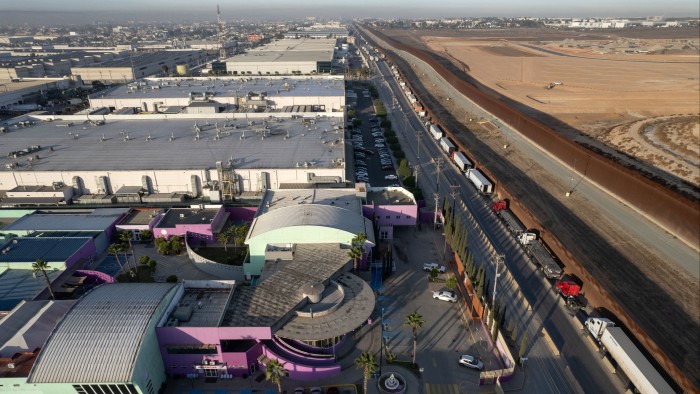Mexico has responded to Donald Trump’s threats of tariffs with tough talk on Tuesday but a slide in the peso highlights just how vulnerable the Latin American nation is to a trade war with its northern neighbour.
Heavily dependent on US trade and investment, suffering a wave of drug-related bloodletting and ruled by a newly inaugurated president, Mexico faces a huge challenge in dealing with the US president-elect.
Trump’s tariff threat on Monday, which would in effect rip up the US’s free trade agreement with its southern neighbour and put a 25 per cent tariff on its exports, was enough to send the Mexican currency down 1.7 per cent against the dollar on Tuesday morning, meaning the peso has fallen almost 20 per cent since April.
About 83 per cent of all of Mexico’s exports go to the US — mainly cars, trucks and electronics goods, with its northern neighbour also investing $236bn in its economy. Remittances sent home by Mexicans from the US totalled $63bn last year.
Yet despite the high stakes, Claudia Sheinbaum, Mexico’s new president, took the step of essentially confronting the US president-elect, reading out a letter to Trump at her morning news conference on Tuesday which she had not yet sent.
The text hinted at retaliation, accused Trump of “probably not being aware” of the work Mexico was doing on migration and took a swipe at the US for its illegal gun exports.
Sheinbaum’s tough talk contrasted with a more conciliatory tone from that of Canadian Prime Minister Justin Trudeau. With Canada also threatened with a 25 per cent tariff, he spoke to the US president-elect privately by telephone on Monday night.

The differences in approach underlined analysts’ concerns over Mexico’s capacity to handle a second Trump term.
“I don’t believe that they were prepared for the realities of the Trump agenda,” said Andrés Rozental, a Mexican former deputy foreign minister and consultant. “They were in La-La-Land, hoping that the constant threats by Trump and his team were not serious and that he would, in any case, be neutralised by the US corporate lobby.”
Even though the president-elect had threatened in the closing stages of his election campaign to slap a 25 per cent tariff on Mexico, the new Mexican government, which took office in October, did not seem to take him seriously.
Sheinbaum played down the rhetoric, telling Mexicans they had nothing to fear and that relations with Washington would be good.
On Monday night, Trump instead berated Mexico for failing to control the flow of illegal immigrants and drugs over the US’s southern border, and threatened tariffs until the situation was fixed.
“Claudia lives in the world of academia while Trump lives in the world of New York real estate dealmaking,” commented Ernesto Revilla, chief Latin America economist at Citi.
William Jackson, chief emerging markets economist at Capital Economics, said that if Trump imposed 25 per cent tariffs on Mexico, the peso could fall as much as 25 per cent, though he cautioned that with so much uncertainty it was hard to make predictions.

Sheinbaum seemingly hoped to continue the approach of her mentor and predecessor Andrés Manuel López Obrador, who struck up an unlikely friendship with Trump, despite coming from opposite ends of the ideological spectrum.
López Obrador responded to Trump’s first-term threats to impose tariffs by cutting a deal: Mexico would control illegal migration from its territory to the US and the Americans would leave him alone on other issues.
Migration fell and the tariff threat was dropped, with Trump putting his name to the USMCA — a revamped free trade deal between the US, Mexico and Canada that came into force in 2020. Mexico overtook China to become the US’s biggest trade partner in 2023.
Irregular migration into the US has also soared, however. Under the Biden administration, almost 6mn migrants were intercepted at the border with Mexico or removed in 2021-23, against 1.6mn in the first three years of Trump’s presidency. American deaths from the synthetic opioid fentanyl, almost entirely imported from Mexico, now stand at more than 80,000 a year.
Among Sheinbaum’s first moves since taking office was a budget that cut spending on security by more than a third — exactly the area where Trump wants Mexico to tighten up.
She has also forged ahead with plans to eliminate independent regulators for banking, telecommunications and competition and to have voters pick all judges, including the supreme court — moves which experts say could contravene the USMCA.
Compounding Sheinbaum’s difficulties is a team which appears ill-equipped to deal with the huge challenge Trump poses.
The Mexican president is yet to name an ambassador to Washington and the low-profile incumbent, Esteban Moctezuma, has made little impact on Capitol Hill over the past six years.
Foreign minister Juan Ramón de la Fuente’s previous US experience was in the UN in New York, rather than in Washington. Marcelo Ebrard, the former foreign minister serving as Sheinbaum’s economy minister, ran against her for the presidential nomination and the two are not close.
López Obrador, who Trump last year called “a fantastic guy”, was adroit in using the migrant issue to put pressure on the US, reminding the Americans he had the power to restrict the flow of people through Mexico towards the border.
But, with the president-elect’s threats to finish building his border wall and use the military to deport illegal aliens, Revilla at Citi noted that it would be “much harder for Mexico this time”.
Additional reporting by Christine Murray in Mexico City
Data visualisation by Janina Conboye and Keith Fray in London
Read the full article here




